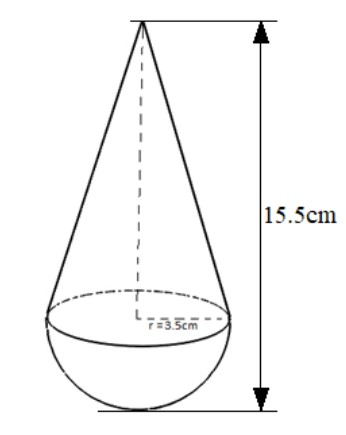Answer
424.2k+ views
Hint:Make a rough diagram with the information given in the question. Check for the areas that are exposed to you. Now calculate the area of the exposed parts of both cone and hemisphere using the formula for curved surface area.
Formula used:Curved surface area of the cone= $\pi r\sqrt {{r^2} + {h^2}}$ and Curved surface area of the hemisphere = $2\pi {r^2}$.
Complete step-by-step answer:
Let’s start everything with making a figure of what the question says.

So, from the above figure it is clear that the total surface area of the toy which is exposed to us is the curved surface area of a cone and curved surface area of the hemisphere.
$ \Rightarrow $ The total surface area of the toy$ = $ Curved surface area of cone$ + $ Curved surface area of hemisphere
Given the question that, radius$\left( r \right)$ of cone and hemisphere is $3.5cm$and the total height of toy, i.e. height of cone$ + $ Radius of the hemisphere is $15.5cm$.
Height of the cone$\left( h \right) = 15.5 - 3.5 = 12cm$
We know that the formula for the curved surface area of the cone is $\pi $ times radius times slant height, i.e. $\pi r\sqrt {{r^2} + {h^2}} $ and for the hemisphere, the formula is twice the radius square times $\pi $, i.e. $2\pi {r^2}$
With these formulas, the above relation can be written as
The total surface area of the toy $ = \pi r\sqrt {{r^2} + {h^2}} + 2\pi {r^2}$
Let us now substitute the known values in the equation
The total surface area of the toy $ = \pi \times 3.5 \times \sqrt {{{3.5}^2} + {{12}^2}} + 2 \times \pi \times {3.5^2}$
Solving this equation with the value of $\pi = 3.141$
The total surface area of the toy$ = 3.14 \times 3.5 \times \sqrt {12.25 + 144} + (2 \times 3.14 \times 12.25)$
On solving it further, you’ll get
The total surface area of the toy$ = 10.99 \times \sqrt {156.25} + (2 \times 38.465) \Rightarrow 10.99 \times 12.5 + 76.93 \Rightarrow 137.375 + 76.93 \Rightarrow 214.3c{m^2}$.
Note:Try to understand what is asking first from the question.Always do the calculation step by step with proper use of braces. An alternative approach could be to find surface areas of both cone and hemisphere separately and then add them up to find the area of the toy.Students should remember formulas of surface areas of both cone and hemisphere for solving these types of questions.
Formula used:Curved surface area of the cone= $\pi r\sqrt {{r^2} + {h^2}}$ and Curved surface area of the hemisphere = $2\pi {r^2}$.
Complete step-by-step answer:
Let’s start everything with making a figure of what the question says.

So, from the above figure it is clear that the total surface area of the toy which is exposed to us is the curved surface area of a cone and curved surface area of the hemisphere.
$ \Rightarrow $ The total surface area of the toy$ = $ Curved surface area of cone$ + $ Curved surface area of hemisphere
Given the question that, radius$\left( r \right)$ of cone and hemisphere is $3.5cm$and the total height of toy, i.e. height of cone$ + $ Radius of the hemisphere is $15.5cm$.
Height of the cone$\left( h \right) = 15.5 - 3.5 = 12cm$
We know that the formula for the curved surface area of the cone is $\pi $ times radius times slant height, i.e. $\pi r\sqrt {{r^2} + {h^2}} $ and for the hemisphere, the formula is twice the radius square times $\pi $, i.e. $2\pi {r^2}$
With these formulas, the above relation can be written as
The total surface area of the toy $ = \pi r\sqrt {{r^2} + {h^2}} + 2\pi {r^2}$
Let us now substitute the known values in the equation
The total surface area of the toy $ = \pi \times 3.5 \times \sqrt {{{3.5}^2} + {{12}^2}} + 2 \times \pi \times {3.5^2}$
Solving this equation with the value of $\pi = 3.141$
The total surface area of the toy$ = 3.14 \times 3.5 \times \sqrt {12.25 + 144} + (2 \times 3.14 \times 12.25)$
On solving it further, you’ll get
The total surface area of the toy$ = 10.99 \times \sqrt {156.25} + (2 \times 38.465) \Rightarrow 10.99 \times 12.5 + 76.93 \Rightarrow 137.375 + 76.93 \Rightarrow 214.3c{m^2}$.
Note:Try to understand what is asking first from the question.Always do the calculation step by step with proper use of braces. An alternative approach could be to find surface areas of both cone and hemisphere separately and then add them up to find the area of the toy.Students should remember formulas of surface areas of both cone and hemisphere for solving these types of questions.
Recently Updated Pages
How many sigma and pi bonds are present in HCequiv class 11 chemistry CBSE

Why Are Noble Gases NonReactive class 11 chemistry CBSE

Let X and Y be the sets of all positive divisors of class 11 maths CBSE

Let x and y be 2 real numbers which satisfy the equations class 11 maths CBSE

Let x 4log 2sqrt 9k 1 + 7 and y dfrac132log 2sqrt5 class 11 maths CBSE

Let x22ax+b20 and x22bx+a20 be two equations Then the class 11 maths CBSE

Trending doubts
Fill the blanks with the suitable prepositions 1 The class 9 english CBSE

At which age domestication of animals started A Neolithic class 11 social science CBSE

Which are the Top 10 Largest Countries of the World?

Give 10 examples for herbs , shrubs , climbers , creepers

Difference between Prokaryotic cell and Eukaryotic class 11 biology CBSE

Difference Between Plant Cell and Animal Cell

Write a letter to the principal requesting him to grant class 10 english CBSE

Change the following sentences into negative and interrogative class 10 english CBSE

Fill in the blanks A 1 lakh ten thousand B 1 million class 9 maths CBSE



